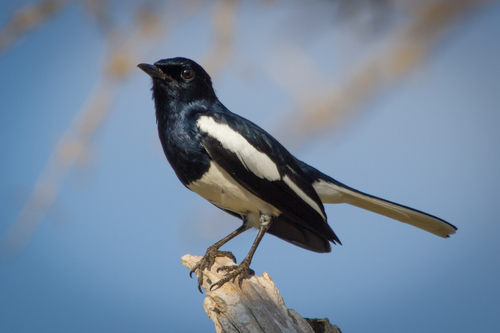
Oriental Magpie-robin
The Oriental Magpie-robin (Copsychus saularis) is a small passerine bird renowned for its striking black and white plumage and melodious song. Once classified as a member of the thrush family, it is now considered an Old World flycatcher. It plays a significant role in its ecosystem as an insectivore, helping to control insect populations. Culturally, it's a popular cage bird in parts of Asia and is often featured in folklore and poetry, appreciated for its beautiful vocalizations.
19-21 cm
Length
28-30 cm
Wingspan
Least Concern
Conservation Status
Distribution
The Oriental Magpie-robin is native to South and Southeast Asia, ranging from Pakistan, India, and Sri Lanka eastward to Indonesia, Thailand, southern China, and the Philippines. They have also been introduced to other regions, including parts of Australia.
Lifespan
The average lifespan in the wild is not well documented but estimated 7-8 years, with captive birds potentially living longer.
Oriental Magpie-robin's Habitat
Habitat Types
Open woodlands, Cultivated areas, Gardens, Parks, Mangrove swamps
Climate Zones
Tropical, Subtropical
Adaptations
They are highly adaptable to human-modified landscapes, often found near human habitation. Their ability to thrive in a variety of habitats, including urban gardens, contributes to their widespread distribution.
Variations
Several subspecies are recognized, differing primarily in the extent of white on the wings and tail, as well as overall size. For example, *C. s. andamanensis* is found in the Andamans and has shorter tail.
Appearance
Breeding Plumage
Males have glossy black upperparts, head, and throat, with a white belly and under-tail coverts. Females are grayish-black above and grayish-white below. There are no significant seasonal variations in plumage beyond slight wear and tear.
Seasonal Feather Changes
Minimal seasonal variation.
Sex Based Plumage Differences
Distinct sexual dimorphism; males are black and white, while females are grayer.
Notable Features
Long tail, often held upright, White wing patches, conspicuous in flight, White outer tail feathers
Diet and Feeding
Primary Foods
Insects, Spiders, Earthworms, Small lizards, Geckos, Leeches
Foraging Behavior
They forage mainly on the ground, hopping and running to catch prey. They also glean insects from leaves and branches and occasionally hawk insects in the air.
Specializations
No specific beak or tongue specializations beyond those typical of insectivorous birds.
Seasonal Diet Variations
Diet may shift slightly depending on insect availability, with a greater reliance on other invertebrates during drier periods.
Behavior
Social Structure
Generally found in pairs or small family groups, especially during the breeding season. They are not highly social outside of breeding.
Communication
Melodious song, often delivered from an exposed perch, Variety of calls, including alarm calls and contact calls, Tail-flicking and wing-flicking are used as visual signals
Migration
Primarily resident (non-migratory), although some local movements may occur in response to food availability or weather conditions.
Territorial or Group Behaviors
Territorial during the breeding season, with males defending their territories through song and aggressive displays.
Conservation
Threats
Habitat loss due to deforestation and urbanization, Pesticide use, which reduces insect prey, Capture for the cage-bird trade (in some regions)
Protection Programs
General wildlife protection laws in many countries within its range, Some protected areas encompass suitable habitat
Local National Laws
Protected under wildlife laws in many countries, such as India's Wildlife Protection Act.
Population Trend
Stable
Population Estimates
While precise global population estimates are difficult, it is considered common and widespread throughout much of its range.
Interesting Facts
They are known for their habit of bathing in dew or rainwater collected on leaves.
This behavior helps them keep their plumage clean.
The Oriental Magpie-robin is the national bird of Bangladesh.
It holds cultural significance and is widely recognized in the country.
They can mimic the calls of other bird species.
This vocal mimicry is thought to be part of their territorial defense or mate attraction.
Faqs about Oriental Magpie-robin
What should I do if I find an injured Oriental Magpie-robin?
Contact a local wildlife rehabilitator or veterinarian. Do not attempt to care for it yourself without expert guidance.
Are Oriental Magpie-robins good pets?
While they are kept as cage birds in some regions, it's generally recommended to appreciate them in their natural habitat. Keeping wild birds can be detrimental to their welfare and is illegal in many places.
How can I attract Oriental Magpie-robins to my garden?
Provide a source of fresh water, plant native trees and shrubs that attract insects, and avoid using pesticides.
Copyright @ Nature Style Limited. All Rights Reserved.
 English
English